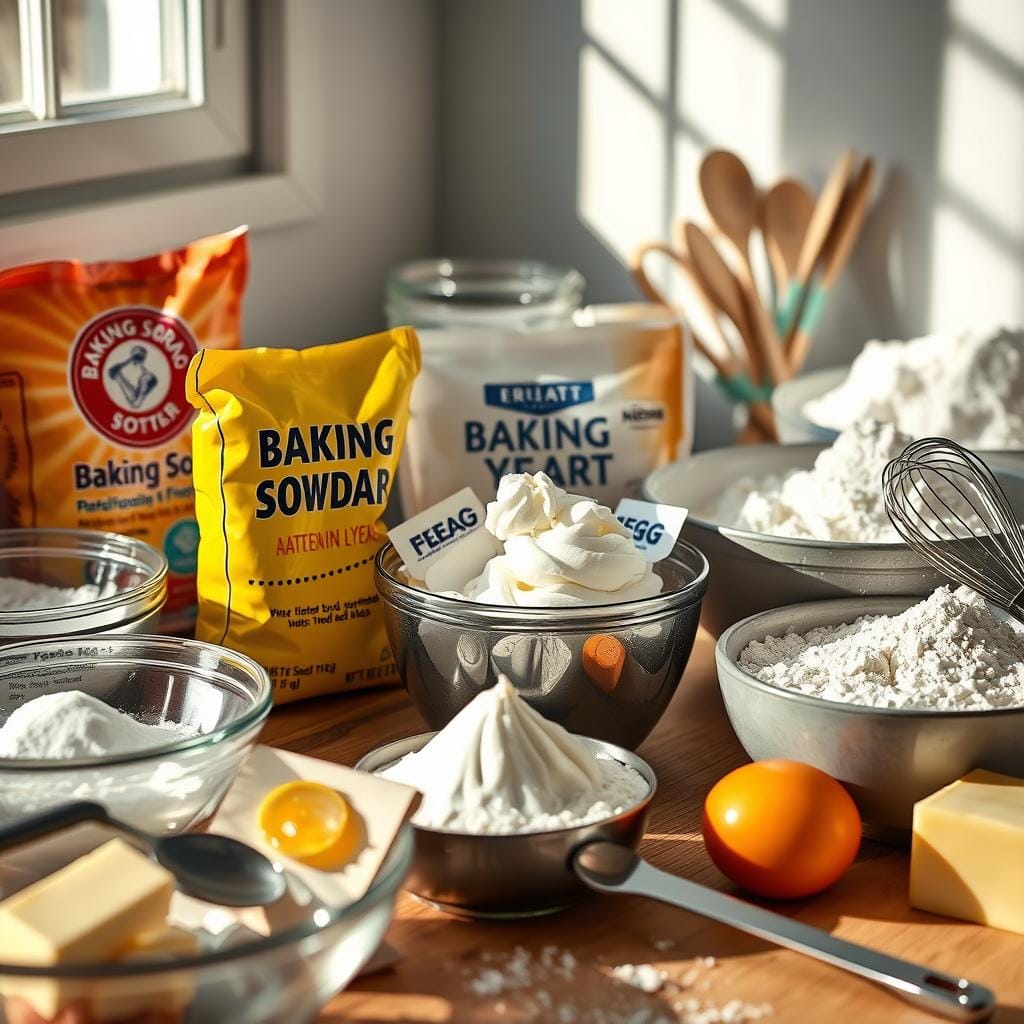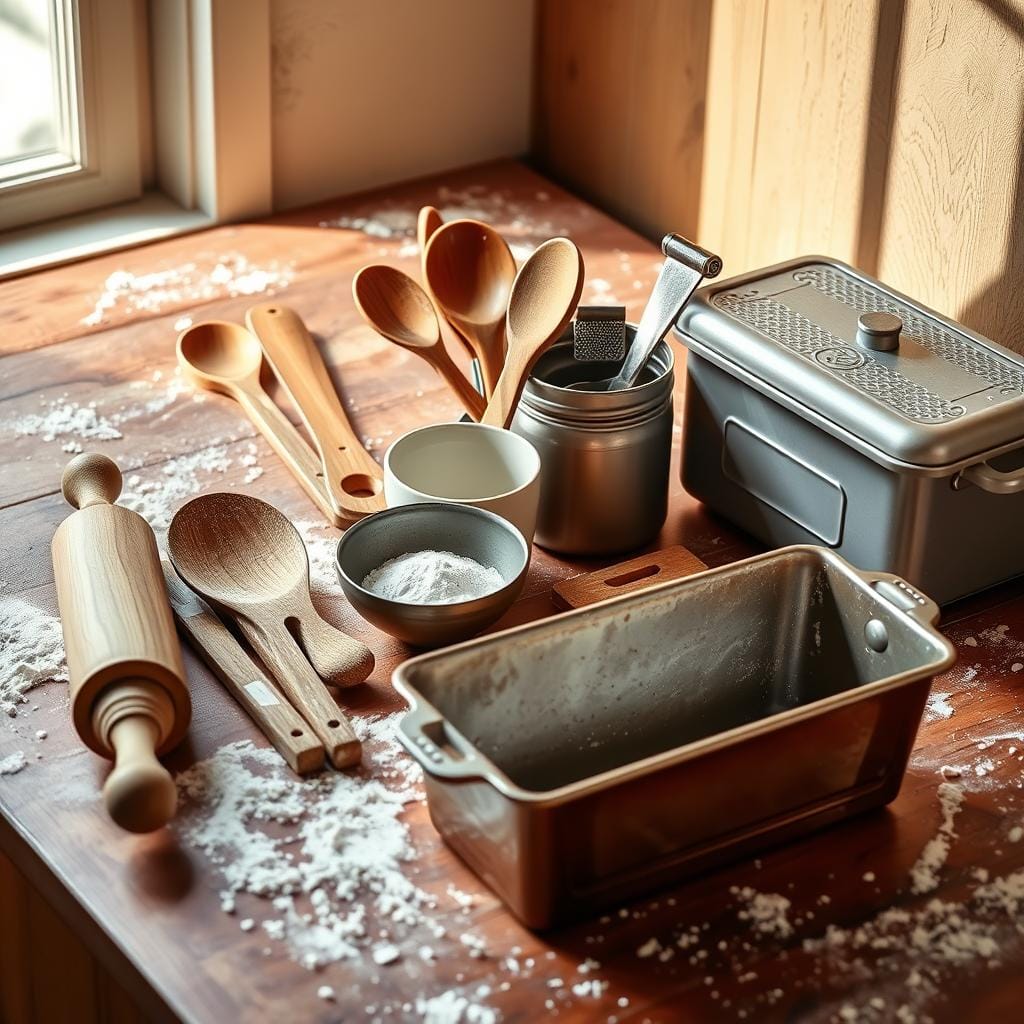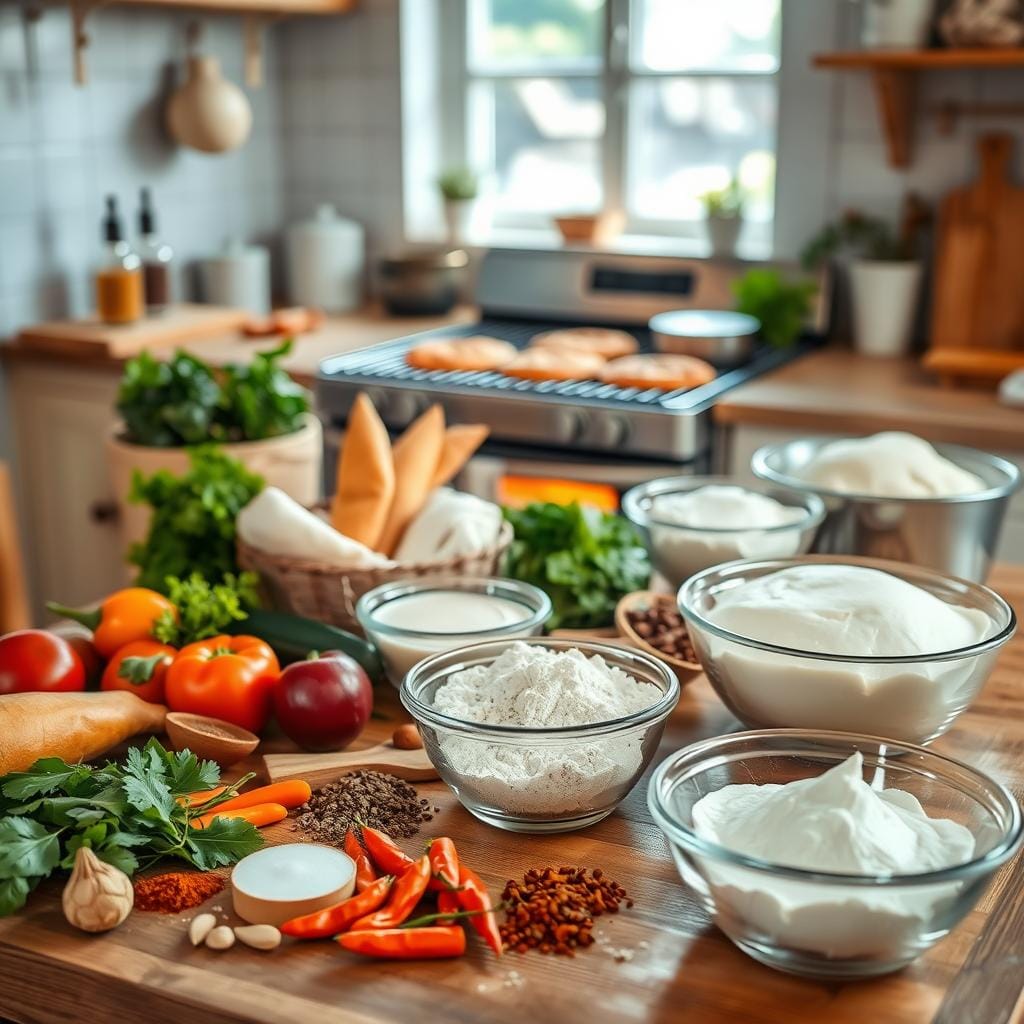Ever dreamed of making bakery-quality breads, flaky pastries, and light cakes at home? The secret is in rising recipes. These recipes, from sourdough to dinner rolls, can transform your kitchen. But what makes them special, and how can you make them part of your cooking? Let’s explore the magic behind these easy techniques.

Key Takeaways
- Discover the benefits of incorporating rising recipes into your home cooking
- Learn the science behind leavening agents and their role in dough rising
- Explore essential equipment and techniques for perfecting your rising recipes
- Tackle common challenges and troubleshoot issues with rising dough
- Expand your repertoire with a variety of sweet and savory rising recipe ideas
Ready to unlock rising recipes and improve your home cooking? Let’s start your journey to becoming a master of homemade dishes!
Understanding the Magic of Leavening in Home Baking
Leavening is the secret to making baked goods light and fluffy at home. You can use chemical leavening agents or yeast fermentation. Knowing the science behind dough rising is crucial for making homemade breads, cakes, and more.
Chemical vs. Biological Leavening Agents
Chemical leavening agents like baking soda and baking powder create gas bubbles through a chemical reaction. Biological leavening from yeast or sourdough starters uses fermentation to produce carbon dioxide. Both methods help bakers achieve different textures and flavors in their baked goods.
The Science Behind Dough Rising
When leavening agents in your dough or batter activate, they release gas bubbles. These bubbles get trapped, causing the mixture to expand and rise. Proper proofing dough techniques, such as kneading and resting, are key to creating a light, airy final product.
Temperature and Environment Factors
The temperature and environment of your kitchen affect leavening. Yeast and chemical agents work best in certain temperature ranges. Humidity levels also impact dough rising. Mastering these factors is essential for consistent baking results.

By understanding leavening science, home bakers can experiment with different techniques and ingredients. This leads to a variety of delicious, perfectly-risen baked goods. From classic yeast breads to light and fluffy cakes, the magic of leavening is in your hands.
Essential Equipment for Perfect Rising Recipes
To make perfectly risen, artisan-quality baked goods at home, you need the right tools. From proofing baskets to scoring knives, having the right items makes a big difference. These tools will help you improve your artisan baking skills and master bread scoring and oven spring.
- Proofing Baskets: These baskets are perfect for your dough to rise. They help it keep its shape and get a beautiful, crisp crust.
- Scoring Tools: A sharp bread lame or knife is key for those signature slashes. It helps your loaves have maximum oven spring.
- Baking Stones: These stones mimic a professional bread oven. They ensure even heat and a perfectly crisp bottom crust.
- Digital Thermometer: It’s important to check the internal temperature of your baked goods. This is especially true for artisan baking.
- Dough Scrapers: These tools are great for handling and shaping dough. They also help scrape up any stuck-on bits from your work surface.
With these essential tools, you’ll be on your way to making stunning, oven spring-filled loaves. They’ll be just like those from the best artisan baking bakeries.

“The right tools can make all the difference in your baking journey. Invest in quality equipment, and you’ll be rewarded with consistent, professional-level results.”
Mastering Basic Sourdough Bread from Scratch
Making delicious sourdough bread from scratch might seem hard. But, with the right steps, you can become a pro at this classic craft. We’ll show you how to make your own sourdough starter, proof your proofing dough, and learn bread scoring for a stunning loaf.
Creating Your Sourdough Starter
A great sourdough bread starts with a lively starter. You’ll need flour, water, and patience. Just follow a simple routine, and in a few days, you’ll have a starter ready to make your dough rise.
- Mix equal parts flour and water in a clean jar, cover, and let sit at room temperature for 24 hours.
- Discard half the mixture and add equal parts fresh flour and water. Repeat this process for 5-7 days until the starter is bubbly and active.
- Once your starter is ready, you can begin using it to make delicious sourdough bread.
Proper Proofing Techniques
Proofing is key in making sourdough bread. It lets the dough rise and get its unique flavor and texture. Learning to proof right is essential for a perfect crumb and crust.
- Allow your dough to proof at the optimal temperature, usually around 75-85°F, for the best results.
- Monitor the dough’s rise, and don’t be afraid to adjust the proofing time as needed based on your specific environment and ingredients.
- Use the “poke test” to determine when your dough is ready to be shaped and baked.
Scoring and Baking Methods
Scoring and baking are the final steps in creating beautiful sourdough bread. By scoring the dough, you allow it to expand in a controlled way, achieving that perfect artisanal look. After scoring, bake the bread to perfection for a crispy crust and soft, flavorful interior.
| Scoring Technique | Effect on Baked Bread |
|---|---|
| Classic Slashes | Creates a classic, rustic look with parallel lines across the top of the loaf. |
| Circular Scoring | Produces a decorative, spiral pattern that enhances the bread’s rise and expansion. |
| Freeform Designs | Allows for creative expression, resulting in unique and visually stunning loaves. |
By mastering these techniques, you’ll be well on your way to baking bakery-worthy sourdough bread right in your own kitchen.
“The secret to great sourdough is patience and a little bit of magic.”
Quick and Easy Rising Recipes for Beginners
Starting your home baking journey can be thrilling yet daunting, especially with rising dough recipes. Don’t worry, we’ve got you covered with simple and quick rising recipes for beginners.
The classic chicken and dressing recipe is a crowd-pleaser. It has fluffy homemade dressing that rises beautifully, paired with tender chicken and savory flavors. Feel free to try different flours – you can can i substitute all-purpose flour for self-rising flour? to find your favorite.
For beginners, simple yeast breads are a great starting point. Try making a basic French bread or dinner rolls. You’ll see the magic of yeast as the dough expands. With practice, you’ll soon be making fresh, homemade bread.
Baking soda and baking powder are also key. These chemical leavening agents make quick breads, biscuits, and pancakes light and moist. Look for recipes that use these ingredients for amazing results.
The secret to success with rising recipes is understanding the science and mastering techniques. With some tutorials and practice, you’ll be making bakery-quality treats at home.
Troubleshooting Common Rising Problems
Baking homemade bread can be rewarding but comes with challenges. You might face issues with proofing dough and leavening agents. These can affect your bread’s texture and rise. But, with the right techniques, you can solve these problems and bake light, airy loaves.
Fixing Dense or Heavy Bread
If your bread is dense, it might be due to proofing dough issues. Make sure you give the dough enough time to rise. Also, check that your leavening agents are fresh and active. Avoid overworking the dough to prevent a dense crumb.
Managing Over-proofed Dough
- Too much rise can make your dough collapse in the oven, leading to a flat loaf. Watch the proofing dough closely and stop it before it gets too big.
- Try adjusting your recipe or proofing area to get the best oven spring.
Temperature Control Solutions
Temperature is key for proofing dough and baking. Keep your kitchen at the right temperature for proofing. Use an oven thermometer to check your oven’s accuracy. Adjusting the temperature can help you get the perfect oven spring and crust.
“Mastering homemade bread baking is about understanding leavening agents and their effect on dough. With some troubleshooting and trying different things, you’ll bake light, fluffy loaves consistently.”
Advanced Techniques for Artisan Bread Making
Take your bread-making to the next level and make professional-quality loaves at home. Learn about scoring and working with enriched doughs. These advanced techniques will change how you make homemade bread.
Mastering Bread Scoring
Bread scoring is key in artisan baking. It’s about slashing the dough before baking. This step makes your bread look great and helps it rise better.
Try different scoring patterns like the cross-hatch, leaf, or feather. These designs add a professional look to your loaves.
Working with Enriched Doughs
Explore enriched doughs with eggs, butter, and sugar. These doughs need care to get a light crumb and golden crust. Learn how to proof, shape, and bake breads like challah or brioche for rich results.
Achieving Professional-Level Results
Get better at artisan baking with techniques like steam injection and using a baking stone. Also, find the right proofing and baking times. These small changes can make your breads have a crisp crust, open crumb, and great flavor.
“The true joy of artisan baking lies in the pursuit of perfection, one loaf at a time.”
Working with Different Types of Flour
Knowing the different flours and their special qualities is key for great baking. Whether making homemade bread or delicate pastries, the flour you pick matters a lot. Let’s look at the differences between self-rising flour and all-purpose flour. We’ll also share tips on how to store and keep them fresh.
Self-Rising vs. All-Purpose Flour
Self-rising flour is a mix of all-purpose flour, baking powder, and salt. It’s great for biscuits, quick breads, and recipes needing a light texture. All-purpose flour, on the other hand, is more flexible. It works for bread, cakes, and cookies.
Storage and Shelf Life Tips
Keeping flour fresh and quality is important. Both self-rising flour and all-purpose flour need to be stored in airtight containers in a cool, dry spot. This keeps moisture, bugs, and other bad stuff out. Self-rising flour lasts about 6 to 12 months, while all-purpose flour can last up to 1 year if stored right.
| Flour Type | Shelf Life | Storage Tips |
|---|---|---|
| Self-Rising Flour | 6-12 months | Store in an airtight container in a cool, dry place. |
| All-Purpose Flour | Up to 1 year | Store in an airtight container in a cool, dry place. |
Knowing about different flours and how to store them well can make your baking a hit. Use self-rising flour and all-purpose flour to your advantage. Let your creativity in the kitchen flourish.
“Flour is the foundation of baking, and understanding its properties is key to unlocking your full potential in the kitchen.”
Sweet and Enriched Dough Creations
Explore the world of sweet and enriched doughs to elevate your baking. These recipes, found in celebrity cookbooks like Snoop Dogg’s, add a twist to traditional baking. You’ll learn to make fluffy brioche and decadent cinnamon rolls in your kitchen.
Enriched doughs use eggs, butter, and sugar for a tender texture. Learning to proof and shape these doughs opens up new possibilities. You can make delicious pastries, sweet breads, and holiday treats.
Baking with these doughs is perfect for special occasions or just for fun. It will improve your baking skills and satisfy your taste buds. Try different flavors and techniques to show off your creativity and make your baking even better.

